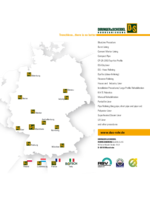The product
Burst lining is a procedure used for the trenchless renewal of sewers, gas and water pipelines. The existing pipe is destroyed and displaced into the surrounding soil, whereas a new pipe with an equal or a bigger diameter is entered simultaneously.
The burst lining allows the renewal of old pipes of stoneware, asbestos-cement, grey cast iron, plastics or unreinforced concrete as well as of steel pipelines with welded joints in a nominal diameter range from DN 80 to DN 700. The result is similar to the laying of a new pipe.
The field of application
In the dynamic burst lining procedure the bursting device is drawn in through the pipe to be renewed. A pneumatically operated percussion piston breaks up the old pipe and displaces the fragments into the surrounding soil. The new media or protection pipe is drawn in simultaneously.
In the static burst lining procedure a bursting rod assembly is led from the start pit to the next construction pit. After the mounting of cutter head and expansion collar the hydraulically operated carriage pulls back the whole rod system with the new pipes.
Installation
In the calibre bursting procedure the outside diameter of the new pipe is smaller than the inside diameter of the old pipe. The old pipe is only displaced on those spots where it is damaged e.g. due to sleeve misalignment, pipe breaks or cracks. The procedure can be used for circular profiles in a nominal diameter range from DN 150 to DN 1 000. The new pipe is drawn in by means of a rocket or a bursting device.
The advantages
A rehabilitation with the burst lining method is carried out without significant impairment of road traffic and the environment. The result is a statically self-supporting and as good as new pipeline with the same nominal diameter as the old pipe. If necessary, the cross-section can be enlarged to improve the hydraulic properties. The low amount of civil engineering work and the short construction time keep the total costs low.
![[Translate to English:] Diringer & Scheidel Rohr [Translate to English:] Logo Diringer & Scheidel Rohr](/fileadmin/media/logos/DuS_Rohr_GmbH_u_Co_KG.svg)
